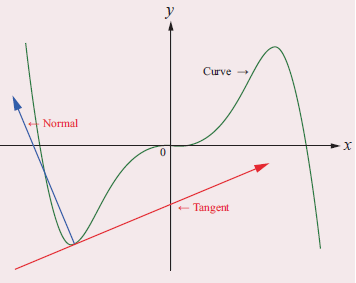FINDING SLOPE OF THE TANGENT LINE AT THE POINT USING DERIVATIVES
Subscribe to our ▶️ YouTube channel 🔴 for the latest videos, updates, and tips.
The tangent line (or simply tangent) to a plane curve at a given point is the straight line that just touches the curve at that point.

Problem 1 :
Find the slope of the tangent to the curves at the respective given points.
(i) y = x4 + 2x2 − x at x = 1
Solution :
y = x4 + 2x2 − x at x = 1
Slope (dy/dx) = 4x3+4x-1
Slope at x = 1 ==> 4(1)3+4(1)-1 ==> 7
So, slope of the tangent at x = 1 is 7.
(ii) x = a cos3t, y = b sin3t at t = π/2
Solution :
|
x = a cos3t dx/dt = 3acos2t(-sint) dx/dt = -3acos2tsint |
y = a sin3t dy/dt = 3asin2t(cost) dy/dt = 3asin2tsint |
dy/dx = 3asin2tsint / (-3acos2tsint)
dy/dx = -sint / cost
(dy/dx) at t = π/2
dy/dx = -sin (π/2) / cos (π/2)
= 1/0
dy/dx = ∞
So, slope of the tangent at x = π/2 is ∞
Problem 2 :
Find the point on the curve y = x2 − 5x + 4 at which the tangent is parallel to the line 3x + y = 7 .
Solution :
Slope of the curve :
y = x2 − 5x + 4
dy/dx = 2x-5 -----(1)
Slope of the line :
3x+y = 7
y = -3x+7
slope (m) = -3 ------(1)
Let (x,y) be the point where we draw the tangent line which is parallel to the given line.
(1) = (2)
2x-5 = -3
2x = 2
x = 1
Applying x = 1 in the equation of the curve, we get
y = (1)2 − 5(1) + 4
y = 0
So, the required point is (1, 0).
Problem 3 :
Find the points on the curve y = x3 − 6x2 + x + 3 where the normal is parallel to the line x + y = 1729.
Solution :
Slope of tangent to the curve :
y = x3 − 6x2 + x + 3
dy/dx = 3x2-12x+1
Slope of normal to the curve :
= -1/3x2-12x+1 ---(1)
Slope of the line :
x + y = 1729
y = -x+1729
Slope (m) = -1 ---(2)
Let (x, y) be the point where we draw tangent line and that is parallel to the given line.
(1) = (2)
-1/(3x2-12x+1) = -1
3x2-12x+1 = 1
3x2-12x = 0
3x(x-4) = 0
x = 0 and x = 4
When x = 0, y = 03 − 6(0)2 + 0 + 3 ==> 3
When x = 4, y = 43 − 6(4)2 + 4 + 3 ==> -25
So, the required points are (0, 3) and (4, -25).
Problem 4 :
Find the points on the curve y2 - 4xy = x2+ 5 for which the tangent is horizontal.
Solution :
Slope of the tangent of the curve :
y2 - 4xy = x2+ 5
2y(dy/dx) - 4[x(dy/dx) + y(1)] = 2x
2y(dy/dx) - 4x(dy/dx) - 4y = 2x
(dy/dx)(2y-4x) = 2x+4y
dy/dx = (2x+4y)/(2y-4x)
dy/dx = (x+2y)/(y-2x)
Since we draw the horizontal tangent, its slope will be equal to 0.
(x+2y)/(y-2x) = 0
x+2y = 0
x = -2y
y2 - 4(-2y)y = (-2y)2+ 5
y2 + 8y2 = 4y2+ 5
5 y2 = 5
y = 1, -1
When y = 1, x = -2
When y = -1, x = 2
So, the required points are (-2, 1) and (2, -1).
Problem 5 :
The normal at the point (1, 1) on the curve 2y + x2 = 3 is
(a) x + y = 0 (b) x - y = 0 (c) x + y + 1 = 0 (d) x - y = 0
Solution :
2y + x2 = 3
Differentiating with respect to x, we get
2(dy/dx) + 2x = 0
2dy/dx = -2x
dy/dx = -2x/2
dy/dx = -x
Slope of tangent at the (1, 1) :
dy/dx at (1, 1) = -1
Slope of normal at (1, 1) :
= -1/-1
= 1
Equation of normal at (1, 1) :
(y - y1) = m(x - x1)
(y - 1) = 1(x - 1)
y = x - 1 + 1
x - y = 0
Problem 6 :
Find the points on the curve
x2/9 + y2/16 = 1
at which the tangents are parallel to Y-axis
Solution :
x2/9 + y2/16 = 1
2x/9 + (2y/16) dy/dx = 0
2x/9 + (y/8) dy/dx = 0
dy/dx = (-2x/9)/(y/8)
dy/dx = (-2x/9)⋅(8/y)
= -16x/9y
The tangent line is parallel to the y-axis, then it must be perpendicular line.
Slope of the perpendicular line = 1/0
-16x/9y = 0
-16x = 0
x = 0
applying x = 0, we get
02/9 + y2/16 = 1
y2/16 = 1
y2 = 16
y = ±4
Hence, the points at which the tangents are parallel to the x-axis are (0,4) and (0,−4).
(ii) The tangent is parallel to the y-axis if the slope of the normal is 0, which gives
−1/(−16/9y) = 0
9y/16 = 0
y = 0
then x2/9 + y2/16 = 1 for y = 0 ⇒ x = ±3
Hence, the points at which the tangents are parallel to the y-axis are (3,0) and (−3,0).
Subscribe to our ▶️ YouTube channel 🔴 for the latest videos, updates, and tips.
Kindly mail your feedback to v4formath@gmail.com
We always appreciate your feedback.
About Us | Contact Us | Privacy Policy
©All rights reserved. onlinemath4all.com
Recent Articles
-
Specifying Units of Measure
Dec 15, 25 07:09 PM
Specifying Units of Measure -
Quantitative Reasoning Questions and Answers
Dec 14, 25 06:42 AM
Quantitative Reasoning Questions and Answers -
Coin Tossing Probability
Dec 13, 25 10:11 AM
Coin Tossing Probability - Concept - Sample Space - Formula - Solved Problems